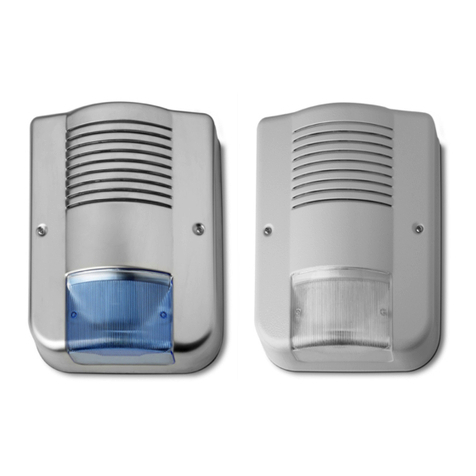Features
The VECTOR Plus GSM interface is used, toghether with an approved telephone set or dialler,
to send and receive telephone calls through the GSM network, when PSTN line is missing.
The interface continuously monitors the PSTN line; when a fault condition is detected VECTOR
Plus switches the telephone equipment connected to its terminals to an internal telephone line
simulation circuit, able to manage calling procedures eventually started by the telephone
equipment, including dial tone and busy tone generation, dialling sequence recognition and
ringng signal generation. Thus VECTOR Plus can be used in a bidirectional way: to send
and/or receive GSM telephone calls.
Additionally, VECTOR Plus can send technical and alarm SMS messages to a maximum of 50
telephone numbers.
VECTOR Plus has also the possibility to send a periodic SMS message (autotest) within a
programmable time interval.
Operation
In normal installations, VECTOR Plus is connected to PSTN line, to alarm telephone dialler and
to telephone handsets of the premise. When the PSTN line voltage (normally 48V) goes below
about 35V, VECTOR Plus starts monitoring the line looking for the dial tone frequency (425Hz
typical). If that signal is not detected within 30 seconds, the interface switches automaticly to
"GSM mode", bringing the alarm dialler to the internal telephone line simulation circuit, whereas
the telephone sets are bypassed directly to the PSTN line.
In this condition, if the dialler attempts to execute a telephone call, VECTOR Plus generates the
dial tone signal like the normal telephone line, and waits the dialling sequence from the external
device (only DTMF dialling is accepted). After the dialling sequence is completed the call is
routed through the GSM unit and VECTOR Plus generates the ringing tone and/or busy tone.
Once the GSM connection is established the voice channel stays open allowing data and voice
signals transfer between the dialler and the called party. At the end of the call, as the dialler
realeases the simulated PSTN line, the GSM connection is interrupted. When terminal "GSM -"
is open, VECTOR Plus waits 60 seconds, after a call through the GSM channel, before
switching back to "PSTN line mode" (normal mode), provided that PSTN line voltage has
returned to its normal value (aprox. 48V).
When the "GSM" terminal is closed to negative or in case of permanent fault of PSTN line,
VECTOR Plus interface allows receiving calls through the GSM channel, since, when an
incoming call is detected by the GSM unit, a valid RING signal is generated at the simulated line
terminals of VECTOR Plus, causing the ring detector of the dialler or the ringing bell of a
telephone to be activated.
Technical characteristics
Power supply voltage: 12V=
Supply voltage tolerance: 11.5 - 15 V=
Current consumption: 300 mA / max 500 mA (when charging GSM battery, if any)
Recommended backup battery: 12V / 1.2 Ah
Dialling mode supported: multifrequency (DTMF)
Dial tone: 425Hz continuous or cadenced (for Italy)
Busy Tone: (425Hz) pulsed
Transmission Protocols supported:
ID CONTACT, FAST, SLOW, SEIA, SIA, VOCAL and half duplex protocols (FAX and MODEM like
protocols are NOT supported)
Dimensions (h x l x w) (mm): 225 x 210 x 80
GSM compatibilities (See technical updates sheet)
3




























